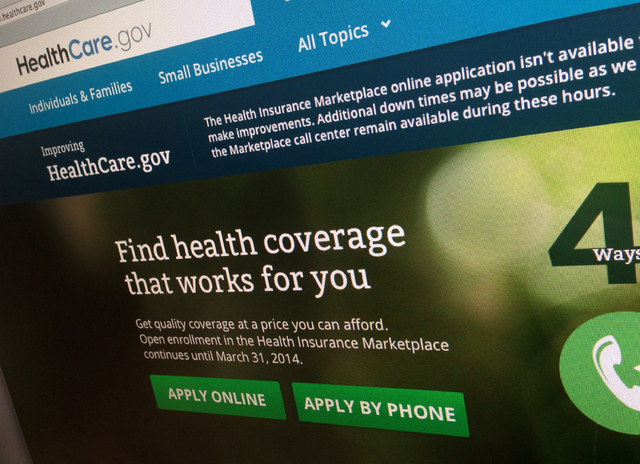Insurance premiums increase under new law
We won’t know just what will happen to Nevada insurance premiums in 2015 until the fall, when the Insurance Division releases carriers’ new rates.
In the Affordable Care Act’s first year, though, Nevada has been dealt some of the highest premium spikes of any state, according to a recent report from the Manhattan Institute and Forbes magazine.
The findings? Nevada was one of just eight states seeing average premium increases of more than 80 percent. (The others were New Mexico, Iowa, Arkansas, Mississippi, Georgia, North Carolina and Vermont.)
Researchers looked particularly at rate changes among people ages 27, 40 and 64. As other analysts have reported, young men fared the worst, with 27-year-olds across the Silver State seeing average monthly premiums jump from $71 to $276, for a 289 percent increase. For 40-year-olds, premiums rose 183 percent, from $119 to $337. And 64-year-olds saw their average rise 124 percent, from $353 to $792.
Nevada’s premium hikes vary by region. A 27-year-old man in Clark County, where doctors’ networks are bigger and buying power is stronger, saw his monthly bill go from $52 to $178, for a 242 percent increase. That same person living in Elko or White Pine counties, however, saw his rate surge from $76 to $354, up 366 percent.
Observers have trouble explaining why Nevada’s rates have risen so much, but Forbes did note that heavily regulated individual insurance markets in states such as New York and Ohio seemed to benefit from big premium cuts.
The latest study backs up a February report by the Kaiser Family Foundation, which found that rural Nevada was the nation’s third most expensive insurance market post-Obamacare.
Of course, consumers who make less than 400 percent of the federal poverty level ($46,680 a year for a single person with no dependents) are getting subsidies to help cover the costs. The Manhattan Institute reported that federal tax credits are covering 76 percent on average of plans sold through state and federal health insurance exchanges.
You can also search premium increases by ZIP code. To plug in your ZIP, visit http://www.forbes.com/special-report/2013/what-will-obamacare-cost-you-map.html.
■ Carl of Las Vegas emailed to let us know that “since the Obamacare has kicked in, medicines have gotten more expensive for us.”
Before we try to figure out how Carl can cut his medical expenses, here’s some background: At 78, he’s on Medicare, the federally run insurance program for seniors. His wife’s insulin has gone from $15 out of pocket per 100 units in 2013 to $114 now. The copay on her painkiller, butalbital, went from $5 to $38.
Carl and his wife are also in Medicare’s drug plan tier 3 — the second-most expensive of four categories. Tier 3 buys patients Medicare-nonpreferred, brand-name prescription drugs, but charges higher copays than lower tiers.
We reached out to insurance broker Len Barend of The Barend Agency to see whether we could help Carl.
First, it’s important to know that the price changes that Carl is seeing aren’t unusual, and they were routine before the Affordable Care Act took effect. Medicare’s drug formularies change annually, so “the movement in price is fairly typical,” Barend said.
Also, the fastest way to reduce Medicare drug expenses is to drop to tier 1, and accept less expensive generic drugs whenever available, Barend said.
That might not be welcome advice to some consumers, who tend to think that lower cost equals lower effectiveness.
But the U.S. Food and Drug Administration requires generics to match brand-name drugs in dosage form, safety, strength, purity, quality and performance characteristics. So the reason generics are less expensive has nothing to do with quality, and everything to do with lower marketing and development costs for the companies that make them. Making the switch can save U.S. consumers $8 billion to $10 billion a year, according to the Congressional Budget Office.
To check for generic versions of brand-name drugs, visit http://www.accessdata.fda.gov/scripts/cder/drugsatfda/index.cfm. Patients can also ask their doctors for help finding generic alternatives.
It might help as well to buy drugs off-plan, where they can be cheaper, Barend said. Carl and other consumers looking to save should hit up pharmacies at Wal-Mart, Costco and Target, he suggested.
■ Two last Obamacare-Medicare notes: The law doesn’t directly affect Medicare benefits, but because lists of accepted drugs and copays change each year, it’s a good idea to have a broker or another insurance industry professional do a quick checkup on the best plans based on prescription needs.
Second, we’ve received a number of emails and letters lately fretting over how the Affordable Care Act has affected Medicare recipients. It’s important to note that the law’s effects haven’t filtered down to seniors yet. The Centers for Medicare and Medicaid Services may eventually shift $715 billion from Medicare to pay for parts of the Affordable Care Act, but that move hasn’t happened yet, Barend said. If and when it does, it’ll lower reimbursements paid to doctors, hospitals and other providers, rather than actual benefits for seniors.
“The changes, if any, are very small now but could change in the future,” Barend said. “That hasn’t really happened yet and if Congress is true to history, they will find a way to keep the compensation where it is or lose too many health care professionals of all types who take Medicare.”




























